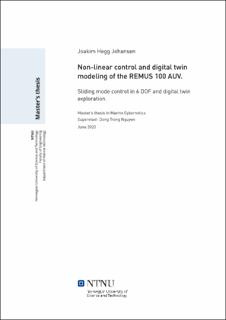| dc.contributor.advisor | Nguyen, Dong Trong | |
| dc.contributor.author | Johansen, Joakim Hegg | |
| dc.date.accessioned | 2021-09-21T16:27:55Z | |
| dc.date.available | 2021-09-21T16:27:55Z | |
| dc.date.issued | 2020 | |
| dc.identifier | no.ntnu:inspera:54166542:20931787 | |
| dc.identifier.uri | https://hdl.handle.net/11250/2780102 | |
| dc.description.abstract | Bruken av autonome undervannsfarkoster (AUV) i krevende, avsidesliggende miljøer involverer risikoen for kollisjoner og tap av fartøy. Koblet og ulineær dynamikk kombinert med underaktuering og usikker hydrodynamikk gjør kontroll av AUVer utfordrende.
Grundig testing av kontrollsystemet er derfor viktig og nødvendig før det distribueres til
den fysiske AUVen.
Mange kontroll algoritmer har blitt utviklet for å håndtere de krevende driftsforholdene
undervannsfartøy operer i. Denne oppgaven presenterer en robust, ulineær kontroll algoritme i 6 frihetsgrader for REMUS 100 AUVen ved å bruke sliding mode (SMC) metoden.
En slik algoritme vil gjøre REMUS 100 i stand til å utføre komplekse oppdrag mens den
er påvirket av forstyrrelser og usikkerhet i modellen. En Simulink simulator er brukt for
å designe kontroll loven og teste prestasjonen. Videre er en sammenligning mellom SMC
og den nåværende kontrolleren som brukes av REMUS 100 presentert.
En digital tvilling (DT) er en digital kopi av en fysisk gjenstand og en kopling mellom den
fysiske og virtuelle verden. I utviklingsprosessen for et kontrollsystem kan en DT brukes
til å teste og optimalisere systemet uten å risikere å skade fartøyet, noe som vil redusere
kostnadene. Ved å bruke en demo av Core Simulation Environment (CSE) vil en numerisk
DT av REMUS 100 lages for å ytterlige teste SMC algoritmen og utforske fordelene ved
DTer.
Resultatene fra simuleringen tilsier at SMC er en passende algoritme for undervannsfarkoster som REMUS 100, men at ytterlige tester må gjennomføres før algoritmen brukes
på det fysiske fartøyet. Videre er mulighetene DTer presenterer mange og vil bare øke med
tiden. | |
| dc.description.abstract | Operating autonomous underwater vehicles (AUV) in harsh, remote environments involves
the risk of collisions and loss of assets. Highly coupled and non-linear dynamics combined
with under-actuation and uncertainties in hydrodynamics makes the control of AUVs challenging. Therefore, comprehensive testing of the control system is crucial and necessary
before deploying it to the physical AUV.
To deal with these demanding operating conditions, various control schemes have been
developed for underwater vehicles. This thesis presents a robust, non-linear control algorithm in 6 degrees of freedom (DOF) for the REMUS 100 AUV using the sliding mode
(SMC) methodology. Such an algorithm would make the REMUS 100 capable of executing complex missions while being affected by environmental disturbances and model
uncertainties. A Simulink simulator is used to design the control law and test its performance. Further, a comparison between the SMC and the existing controller of the REMUS
100 is presented.
A digital twin (DT) is a digital replica of a physical asset and a bridging between the physical and virtual world. In the development phase of a control system, a DT would provide
testing and optimization without the risk of damaging the real asset, thus reducing the cost.
Using the Core Simulation Environment (CSE) demo application a numerical DT of the
REMUS 100 is created to further test the SMC and explore the benefits of DTs.
Results from the simulation suggest that the SMC is a suitable control scheme for underwater vehicles such as the REMUS 100, but that further tests are needed before deploying
the algorithm to the physical asset. Moreover, the possibilities DTs present are many and
will only increase with time. | |
| dc.language | | |
| dc.publisher | NTNU | |
| dc.title | Non-linear control and digital twin modeling of the REMUS 100 AUV. | |
| dc.type | Master thesis | |
